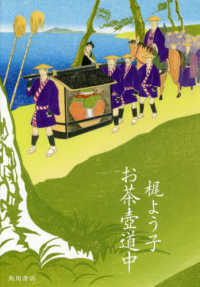- ホーム
- > 洋書
- > 英文書
- > Nature / Ecology
Full Description
Arthropods are invertebrates that constitute over 90% of the animal kingdom, and their bio-ecology is closely linked with global functioning and survival.
Arthropods play an important role in maintaining the health of ecosystems, provide livelihoods and nutrition to human communities, and are important indicators of environmental change. Yet the population trends of several arthropods species show them to be in decline. Arthropods constitute a dominant group with 1.2 million species influencing earth's biodiversity. Among arthropods, insects are predominant, with ca. 1 million species and having evolved some 350 million years ago. Arthropods are closely associated with living and non-living entities alike, making the ecosystem services they provide crucially important. In order to be effective, plans for the conservation of arthropods and ecosystems should include a mixture of strategies like protecting key habitats and genomic studies to formulate relevant policies for insitu and ex situ conservation.
This two-volume book focuses on capturing the essentials of arthropod inventories, biology, and conservation. Further, it seeks to identify the mechanisms by which arthropod populations can be sustained in terrestrial and aquatic ecosystems, and by means of which certain problematic species be managed without producing harmful environmental side-effects.
This edited compilation includes chapters contributed by over 80 biologists on a wide range of topics embracing the diversity, distribution, utility and conservation of arthropods and select groups of insect taxa. More importantly, it describes in detail the mechanisms of sustaining arthropod ecosystems, services and populations. It addresses the contribution of modern biological tools such as molecular and genetic techniques regulating gene expression, as well as conventional, indigenous practices in arthropod conservation. The contributors reiterate the importance of documenting and understanding the biology of arthropods from a holistic perspective before addressing conservation issues at large. This book offers a valuable resource for all zoologists, entomologists, ecologists, conservation biologists, policy makers, teachers and students interested in the conservation of biological resources.
Contents
1. Arthropods: Evolution and Ecology
A. K. Chakravarthy, Vasudev Kammar and P. R. Shashank
2. Soil biodiversity and arthropods: Role in soil fertility
D. J. Bagyaraj, C. J. Nethravathi and K. S. Nitin
3. Butterfly Communities of Ritchie's Archipelago in Andaman and Nicobar Islands, India: Implications for Conservation of Arthropods and Their Habitats
C. Sivaperuman and K. Venkataraman
4. Documenting Arthropods in select Wild and Cultivated Ecosystems in Iran and Kuwait
A. A. Seraj, M. Esfandiari and Wasmia Al-Houty
5. An Appraisal of Select Insect Taxa in Sri Lanka
J. P. Edirisinghe, W. A. I. P. Karunaratne, I. I. Hemachandra, N. R. Gunawardene and C. M. D. Bambaradeniya
6. Utility of arthropods by indigenous communities: Sustaining natural resources
M. Jayashankar, M. Charles, Vijeth V. Arya and Jayalaxmi Hegde
7. Insects as human food
A. K. Chakravarthy, G. T. Jayasimha, R. R. Rachana and G. Rohini
8. Arthropod communities on Rice: A blend of terrestrial and aquatic species
L. Vijay Kumar, K. S. Nitin and Rajendra Prasad
9. Arthropods on cotton: A comparison between Bt and non-Bt cotton
A. K. Chakravarthy, Manja Naik and T. N. Madhu
10. Arthropod Biodiversity on Jute and Allied Fibre Crops
K. Selvaraj, B. S. Gotyal, S. P. Gawande, S. Satpathy and S. K. Sarkar
11. Arthropod Diversity and Management in Legume Based Cropping Systems in the Tropics
V. Sridhar and L. S. Vinesh
12. Arthropod diversity in non-leguminous vegetable crops
N. R. Prasannakumar, K. P. Kumar and A. T. Rani
13. Diversity of Mites on Vegetable crops, Kerala, South India: Documentation for Conserving Predatory and other Beneficial Mites on Vegetables
K. V. Binisha, Haseena Bhaskar and Sosamma Jacob
14. Arthropod Communities Associated with Mango (Mangifera indica L.): Diversity and Interactions
Poluru Venkata Rami Reddy and Kolla Sreedevi
15. Arthropod communities on cashew: A perennial reservoir of species assemblages
P.S. Bhat, K. Vanitha, T.N. Raviprasad and K. K. Srikumar
16. The Coconut Mite: Current Global Scenario
N. S. Aratchige, A. D. N. T. Kumara and N. I. Suwandharathne
17. Arthropod communities in coffee: Reflecting tropical forest arthropod communities
N. E. Thyagaraj, Manjunath Reddy, B. Doddabasappa and S. Onkara Naik
18. Arthropod Pests and Natural Enemies Communities in Tea Ecosystems of India
Narayanannair Muraleedharan and Somnath Roy
19. Forest Arthropod Communities in India: Their role and Conservation
G. Mathew, K. P. Kumar and M. Chandrashekhariah
20. Awareness on Pesticide Residues in Food Crops: A Challenge
G. V. Ranga Rao, B. Ratna Kumari, K. L. Sahrawat and S. P. Wani








